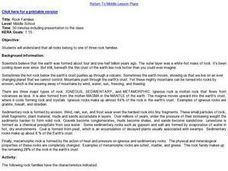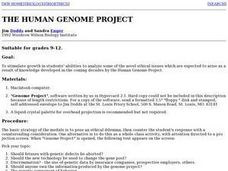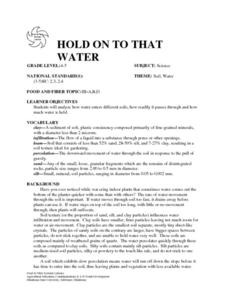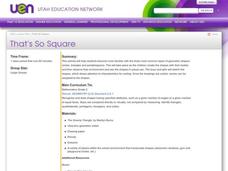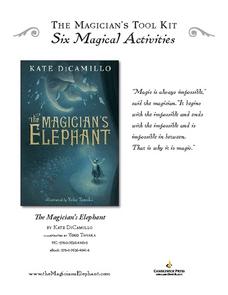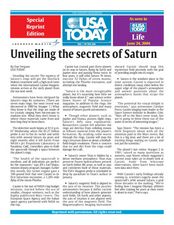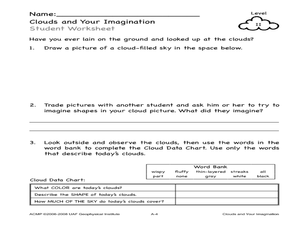Curated OER
Bling and Sound-Symbolic Words
Students explore the definition and derivation of the popular term "bling" and other sound-symbolic words. Using worksheets and lecture materials, students provide meanings for the word "bling" when used in varying contexts. They...
Curated OER
Rock Families
Students study the three types of rock characteristics; igneous, sedimentary, and metamorphic. They are divided into three groups and each group takes one of the rock characteristics. They then act out the characteristics of their rock...
Curated OER
Are You Being Poisoned by Your Dishes?
Students explore lead poisoning and how it relates to ceramic dishes. They perform an experiment to discover if any of your ceramic ware is leaching lead which might cause lead poisoning.
Curated OER
The Human Geonome Project
Students explore the Human Genome Project (HGP). Students research a fact situation, examine genetic data given, and discuss choices available for a solution. Students consider the ethical question and consequences of each choice.
Curated OER
Lead Poisoning and Ceramic Dishes
Young scholars explore the amount of lead in ceramic plates through an experiment. Students determine if everyday dishware is leaching lead into food. They chart their results and discuss how much lead in ceramic dishware may cause...
Curated OER
Building an Ecologically Balanced Living Space
Students design and build an ecologically balanced living space based on the principles of an old growth forest. They take one part of a house (or structure in the community) and redesign it according to the principles of the forest cycle.
Curated OER
What Do We Have In Common?
Seventh graders perform a dissection on a mussels and label their internal organs. In groups, they compare and contrast the mussels structure to those of human beings. They also review the functions that are necessary for survival and...
Curated OER
Protein Exploration
Twelfth graders examine protein shapes through a computer program that can be downloaded off the Internet. The program allows students to see how proteins look when viewed with X-ray crystallography.
Curated OER
HOLD ON TO THAT
Students will analyze how water enters different soils, how readily it passes through and how much water is held.1. Materials needed for the activity are; pint of clay, pint of sand, pint of loam, newspaper,
three frozen fruit juice...
Curated OER
That's So Square
Second graders are introduced to circles, triangles and parallelograms. As a class, they create the shape with their bodies and are shown the shapes in their actual size. To end the lesson plan, they sketch each shape and identify their...
Curated OER
Atoms, Kinetic Theory, Solids and Fluids
Students identify and describe the building blocks that make up an atom. They also compare the ages of atoms to the ages of the materials they compose,as well as, give examples that illustrate the small size of atoms.
Curated OER
Estuary
Students discuss how the meanings of words can change over time. Through discussion, lecture, and activities, they identify how words can have multiple meanings and how those meanings can be changed over time. Lesson resources are...
Curated OER
Spotlight on Students
First graders participate in social skills activities at the beginning of they school year that including graphing work. Each student acts as the "Top Banana" while other students ask them questions about their likes and dislikes. As a...
Curated OER
Voil! C'est La Magie De La Chimie
Students examine chemistry and demonstrate the relevancy of it in their everyday world. In this chemistry lesson students complete a lab activity.
Curated OER
The Magician's Elephant
Students explore the fiction book, "The Magician's Elephant." In this literary lesson/activity, students complete extension activities that coordinate with the reading, including magic tricks, and a writing activity.
Curated OER
Unit 13: Graphs, Correlation, Line of Best Fit
Students explore the concepts of graphs, correlations, line of best fit, and the dipstick problem. In this graph, correlation, line of best fit and dipstick problem lesson, students solve problems on the above mentioned topics. ...
Curated OER
Book Report Haiku
Students study another method for writing a book report using a Haiku poem. In this book report lesson, students use the Haiku poem format to write a book report.
Curated OER
Unveiling the Secrets of Saturn
Students read and study an article then answer questions on Saturn. In this investigative lesson students identify ways space exploration has helped humanity and then they search the Internet for space pictures and sketch a drawing of...
Curated OER
Clouds and Your Imagination
Students study and illustrate clouds. In this cloud study lesson, students study clouds and then illustrate what they see. Students use their imaginations to interpret images from the cloud picture they drew.
Curated OER
Evaluating Music
Students identify an object by drawing something that reminds them of how they feel when they are calm or at peace. In this music lesson, students depict a musical instrument making peaceful music, and then an instrument making loud...
Curated OER
Rock Sorting Activity
Students organize rock samples according to their properties. In this earth science instructional activity, students predict whether they are igneous, metamorphic or sedimentary. They compare their prediction with the actual type.
Other popular searches
- Growing Crystals
- Growing Salt Crystals
- Borax Crystals
- Making Crystals
- Crystals Snowflakes
- Salt Crystals
- Copper Crystals Sulfate
- Rock Crystals
- Forming Crystals
- Ice Crystals
- Geometric Solids Crystals
- Sugar Crystals



